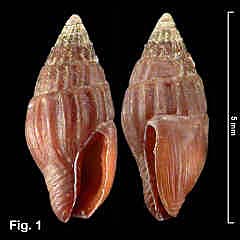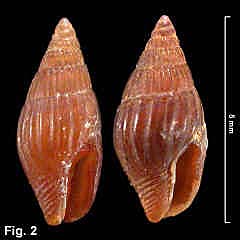|
|
|
|
|
Zafra atrata (Gould, 1860) Description: Shell solid, opaque, whorls rounded, aperture more than 1/3 shell length. Axial sculpture of strong ribs; on the last third of body whorl these are weaker and irregularly spaced, or restricted to top third of whorl. Spiral cord sometimes present below suture, weakly nodulose at intersection with axials; about 8 cords on base. Outer lip sinuous in profile, thickened externally; also thickened internally, with about 5 denticles in mature shells. Columella callus sharp edged, weakly dentate along outer edge; no deep groove at top internally. Siphonal canal slightly upturned, notch shallow. Colour internally and externally mid- to dark brown. Size: Up to 5.5 mm in length. Distribution: Indo-West Pacific; in eastern Australia, as far south as Sydney, NSW. Habitat: In estuaries, including the seaward side of mangrove swamps, under stones and litter, and on seagrass; intertidal and shallow subtidal. Common. Comparison: The dark brown colour and relatively large size separates this from the other Zafra species in NSW. Synonymy: Zafra regulus (Souverbie, 1864) and Zafra darwini (Angas, 1877) are probably synonyms. Zafra avicennia (Hedley, 1915) is a synonym based on specimens from among Avicennia mangroves around Sydney. Remarks: There is variation in the height to width ration as seen in Fig. 2 which shows two specimens from the same lot from Lindeman Island, Queensland. Shells from around Sydney have about 17 axials on the penultimate whorl, this increasing to about 25 in some central Queensland specimens. The spire is normally eroded in this species. Fig. 1: Port Hacking, NSW (C.335343) Fig. 2: Lindeman Island, Queensland (Both C.304503) |

